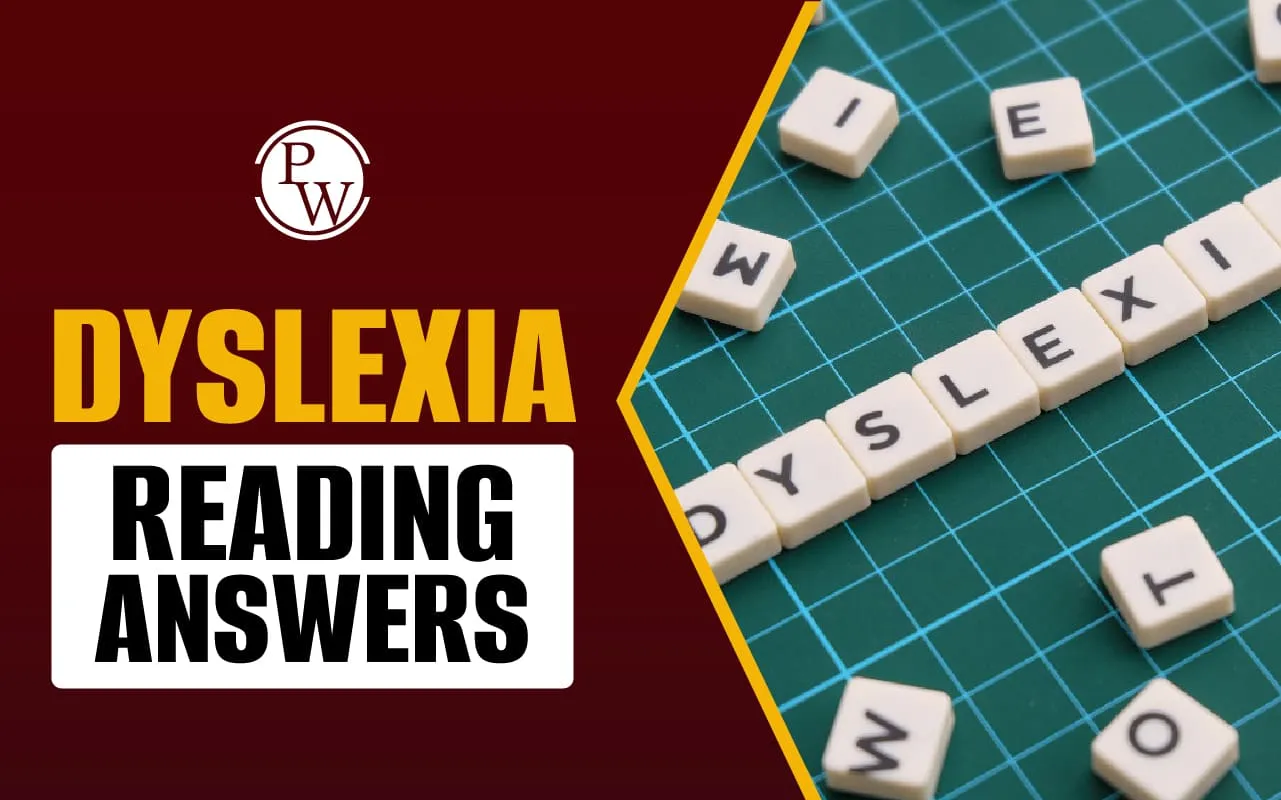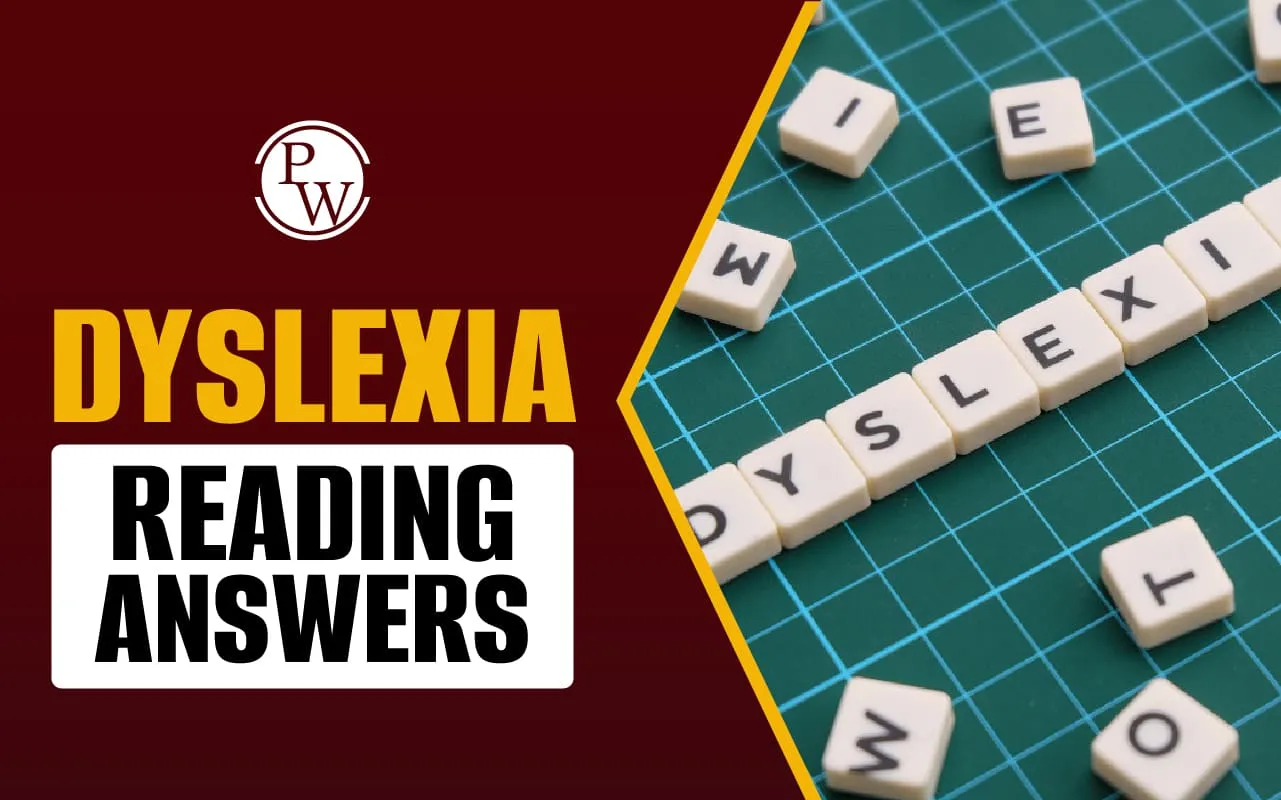

Dyslexia Reading Answers: The IELTS Reading section features a detailed passage on Dyslexia Reading Answers, which explores the causes, brain function differences, and possible treatments for dyslexia. This passage includes a total of 14 questions, divided into True/False/Not Given, Multiple Choice, and Sentence Completion formats. Understanding how to scan for keywords and locate information quickly is crucial for success. Practicing similar questions will help you improve your reading skills and boost your IELTS band score.
Dyslexia Reading Answers Passage
Dyslexia
A. People who left school unable to read were often dismissed as being lazy. Some probably were, but many were simply unable to learn because they were dyslexic. Four key findings now suggest that dyslexia is an organic problem and not a motivational one. Firstly, the brain anatomy of dyslexics differs slightly from those of non dyslexics. Secondly, their brain functions as measured by electrical activity are dissimilar. Thirdly, they have behavioural differences apart from an inability to read. Finally, there is more and more evidence to suggest that their condition is linked to particular genes.
B. The anatomical differences between the brains of dyslexics and non- dyslexics were first noticed in 1979 by Albert Galaburda of Harvard Medical School. He found two sorts of microscopic flaws in the language centres of dyslexic’s brains. These are called ectoplasm and microgyria.
C. The language centres form part of the cerebral cortex and are situated on the left side of the brain. The cortex consists of six layers of cells. An ectopia is a collection of nerve cells that push up from the lower layers of the cortex into the outer ones, where they are not normally found. A microgyrus is a small fold in the cortex which results in a reduction in the normal number of layers from six to four.
D. The formation of microgyria causes confusion in the neutral connections between the language centers and other parts of the brain. Microgyria have been induced in rat embryos and as adults these rats are found to have a reduced ability in distinguishing between two sounds played in quick succession. This inability to distinguish between two sounds in quick succession is also a symptom of dyslexia in people.
E. Dyslexia not only affects language centres but also causes brain abnormalities in visual pathways as well. One such abnormality is the reduction in the cell size in the layers of the lateral geniculate nucleus. This is where the nerve tracts which transmit information from the eyes to the visual cortex at the back of the brain are found. This is significant as dyslexia is essentially an inability to deal with linguistic information in visual form.
F. This parallel failure of visual and auditory systems is seen elsewhere in the brain. Guinevere Eden and Thomas Zeffiro, who work at Georgetown University in Washington D. C. have found an example of it using a brain scanning technique called functional magnetic resonance imaging.(MRI)
G. A fundamental characteristic of dyslexia is difficulty in processing written phenomes. Phenomes are the units of sound which make up a language. By giving dyslexic people tasks such as removing phenomes from the beginning of words, while at the same time monitoring brain activity with their scanner, Dr Eden and Dr Zeffiro were able to stimulate both the visual and auditory pathways simultaneously. Their findings demonstrated that dyslexics showed low activity in a part of the brain called Brodmann’s area 37, another part of the brain where visual and auditory information are handled in close proximity.
H. Dr Eden and Dr Zeffiro have also compared the brain activity of dyslexic and non- dyslexic readers who were given a task not related to reading. Another symptom of dyslexia is difficulty in detecting visual motion. On this basis Dr Eden and Dr Zeffiro devised a task whereby people were asked to look at dots on a screen and identify which of them was moving and in which direction. While monitoring brain activity with the scanner, it was found that dyslexics performing this task showed significantly less brain activity in Brodmann’s area 37 than non-dyslexics. As this task did not require reading skills it could be used to test children for incipient dyslexia before they reach the reading age; then they could be given special tuition.
I. To broaden their investigation, Dr Eden and Dr Zeffiro teamed up with Frank Wood and his colleagues at the Wake Forest University School of Medicine in North Carolina, an institution specializing in dyslexia. Dr Eden and Dr Zeffiro borrowed some of its patients and monitored them in the MRI machine at Georgetown University. This was done both before and after the individuals had participated in an intensive programme designed to improve their reading. Non- dyslexics were also scanned and used as controls in the investigation.
J. The results were significant. After the programme, the participants showed enhanced brain activity while reading. However, this activity was not on the left side of the brain but in areas on the right side, corresponding exactly to language centers in the opposite hemisphere. The reading programme had stimulated the brains of the participants to recruit batches of nerve cells in a place not normally associated with language processing.
K. The primary cause for these problems is another of Dr Wood’s interests. The abnormal brain tissue in dyslexia is developed by the fifth month of gestation, which indicates that the cause of the disorder must act before that time. This suggests that it may be genetic. Many people argue about the relative contributions of genes and the environment to human behaviour and human disease. Dyslexia is both behavioural and, to a certain degree, it is a disease. It appears to have a biological origin and genetic roots. Yet looking at it from a different angle its cause is almost purely environmental. People living in illiterate societies are hardly troubled by its other symptoms. It was the invention of writing that brought the difficulty to light, not the mutation of genes. Nature or environment? You will have to decide between the two.
| IELTS Exam Important Links | |
|---|---|
| IELTS Reading Band Score | IELTS Listening Band Score |
| IELTS Speaking Band Score | IELTS Writing Band Score |
Dyslexia Reading Answers Sample Questions
IELTS True/False/Not Given
(Write True if the statement agrees with the information, False if it contradicts the information, and Not Given if there is no information on this.)
1. Dyslexia is primarily caused by a lack of motivation in individuals.
2. Microgyria causes issues in the connection between language centres and other brain areas.
3. Dyslexic individuals have difficulty in identifying individual letters.
4. Dyslexia only affects the language centres of the brain.
5. The MRI technique used by Dr Eden and Dr Zeffiro showed high activity in Brodmann’s area 37 in dyslexics.
6. Dyslexia can be completely cured with early intervention.
IELTS Reading Multiple-Choice Questions
(Choose the correct letter A, B, C, or D.)
7. According to the passage, what is one major difference found in the brains of dyslexic individuals?
-
A) Larger cerebral cortex
-
B) Extra nerve cells in unexpected layers of the cortex
-
C) Thinner brain tissue
-
D) Increased electrical activity in the brain
8. What conclusion did Dr Eden and Dr Zeffiro reach after testing dyslexics on visual motion tasks?
-
A) Dyslexics showed normal activity in Brodmann’s area 37.
-
B) Dyslexics processed visual motion faster than non-dyslexics.
-
C) Dyslexics showed lower brain activity in Brodmann’s area 37.
-
D) Dyslexics were unable to identify visual motion altogether.
9. What significant change was observed after participants completed the reading improvement programme?
-
A) Increased activity in the language centres on the left side of the brain.
-
B) Enhanced brain activity in the right hemisphere.
-
C) Complete recovery from dyslexia.
-
D) No noticeable improvement in brain activity.
10. According to the passage, which factor is considered a possible cause of dyslexia?
-
A) Exposure to certain chemicals
-
B) Brain injuries after birth
-
C) Genetic influence during early brain development
-
D) Poor reading habits
11. What was the purpose of testing dyslexic individuals on non-reading tasks?
-
A) To confirm that dyslexia only affects reading ability
-
B) To identify brain activity patterns unrelated to reading
-
C) To prove that dyslexia is not a real condition
-
D) To compare the reading speed of dyslexic and non-dyslexic individuals
IELTS Reading Sentence Completion
(Complete the sentences below using NO MORE THAN THREE WORDS from the passage.)
12. Microgyria reduces the number of brain layers from six to __________.
13. Dyslexia is linked to difficulties in processing written __________.
14. Dyslexia appears to have both biological and __________ origins.
Dyslexia Reading Answers with Explanations
1. Dyslexia is primarily caused by a lack of motivation in individuals.
-
Answer: False
-
Location: Paragraph A
-
Reference: "People who left school unable to read were often dismissed as being lazy. Some probably were, but many were simply unable to learn because they were dyslexic."
-
Explanation: This indicates that dyslexia is not caused by a lack of motivation but by an organic problem.
2. Microgyria causes issues in the connection between language centres and other brain areas.
-
Answer: True
-
Location: Paragraph D
-
Reference: "The formation of microgyria causes confusion in the neutral connections between the language centers and other parts of the brain."
-
Explanation: The passage confirms that microgyria disrupt the connection between the brain’s language centres and other regions.
3. Dyslexic individuals have difficulty in identifying individual letters.
-
Answer: Not Given
-
Location: Not mentioned in the passage.
-
Explanation: The passage mentions difficulty in processing phonemes and distinguishing sounds but does not refer to difficulty in identifying letters.
4. Dyslexia only affects the language centres of the brain.
-
Answer: False
-
Location: Paragraph E
-
Reference: "Dyslexia not only affects language centres but also causes brain abnormalities in visual pathways as well."
-
Explanation: The passage explicitly states that dyslexia affects both language and visual processing areas. The statement contradicts the passage, so the answer is "False."
5. The MRI technique used by Dr Eden and Dr Zeffiro showed high activity in Brodmann’s area 37 in dyslexics.
-
Answer: False
-
Location: Paragraph F
-
Reference: "Their findings demonstrated that dyslexics showed low activity in a part of the brain called Brodmann’s area 37."
-
Explanation: The passage indicates that dyslexics showed reduced, not increased, activity in Brodmann’s area 37. The statement contradicts the passage, so the answer is "False."
6. Dyslexia can be completely cured with early intervention.
-
Answer: Not Given
-
Location: Not mentioned in the passage.
-
Explanation: Since the passage does not provide any information about a cure for dyslexia, the answer is "Not Given."
7. According to the passage, what is one major difference found in the brains of dyslexic individuals?
-
Answer: B) Extra nerve cells in unexpected layers of the cortex
-
Location: Paragraph C
-
Reference: "An ectopia is a collection of nerve cells that push up from the lower layers of the cortex into the outer ones, where they are not normally found."
-
Explanation: The passage describes the presence of extra nerve cells (ectopias) in unexpected brain areas in dyslexic individuals.
8. What conclusion did Dr Eden and Dr Zeffiro reach after testing dyslexics on visual motion tasks?
-
Answer: C) Dyslexics showed lower brain activity in Brodmann’s area 37.
-
Location: Paragraph H
-
Reference: "It was found that dyslexics performing this task showed significantly less brain activity in Brodmann’s area 37 than non-dyslexics."
-
Explanation: The passage directly states that dyslexics showed reduced brain activity in Brodmann’s area 37.
9. What significant change was observed after participants completed the reading improvement programme?
-
Answer: B) Enhanced brain activity in the right hemisphere.
-
Location: Paragraph J
-
Reference: "After the programme, the participants showed enhanced brain activity while reading… in areas on the right side of the brain."
-
Explanation: The passage states that the increased activity occurred in the right hemisphere rather than the left.
10. According to the passage, which factor is considered a possible cause of dyslexia?
-
Answer: C) Genetic influence during early brain development
-
Location: Paragraph K
-
Reference: "The abnormal brain tissue in dyslexia is developed by the fifth month of gestation, which indicates that the cause of the disorder must act before that time."
-
Explanation: The passage links dyslexia to genetic factors influencing early brain development.
11. What was the purpose of testing dyslexic individuals on non-reading tasks?
-
Answer: B) To identify brain activity patterns unrelated to reading
-
Location: Paragraph H
-
Reference: "As this task did not require reading skills it could be used to test children for incipient dyslexia before they reach the reading age."
-
Explanation: The passage explains that the purpose was to understand brain activity patterns not directly linked to reading.
12. Microgyria reduces the number of brain layers from six to __________.
-
Answer: Four
-
Location: Paragraph C
-
Reference: "A microgyrus is a small fold in the cortex which results in a reduction in the normal number of layers from six to four."
-
Explanation: The passage directly states that microgyria reduces the number of brain layers to four.
13. Dyslexia is linked to difficulties in processing written __________.
-
Answer: Phenomes
-
Location: Paragraph G
-
Reference: "A fundamental characteristic of dyslexia is difficulty in processing written phenomes."
-
Explanation: The passage identifies phoneme processing issues as a core symptom of dyslexia.
14. Dyslexia appears to have both biological and __________ origins.
-
Answer: Environmental
-
Location: Paragraph K
-
Reference: "Dyslexia is both behavioural and, to a certain degree, it is a disease. It appears to have a biological origin and genetic roots. Yet looking at it from a different angle its cause is almost purely environmental."
-
Explanation: The passage states that dyslexia stems from both biological and environmental factors.
Also Read:
- Should You Use All Capital Letters in the IELTS Listening and Reading Tests
- IELTS Reading Mistakes
- How to Improve IELTS Reading Score
- How to Manage Time in IELTS Reading
Guidance of PW IELTS
Physics Wallah offers multiple online IELTS courses for all students. Follow the IELTS pages to better prepare for the exam.
| What is IELTS Exam? | Documents Required for IELTS Registration |
| IELTS exam eligibility requirements | IELTS Exam Fees |
| IELTS test results | IELTS Exam Pattern |
Dyslexia Reading Answers FAQs
What anatomical differences in the brain were first discovered in dyslexic individuals?
How does microgyria affect brain function in dyslexics?
Can dyslexia be diagnosed before a child starts reading?
How did the brain activity of dyslexics change after completing a reading improvement programme?












